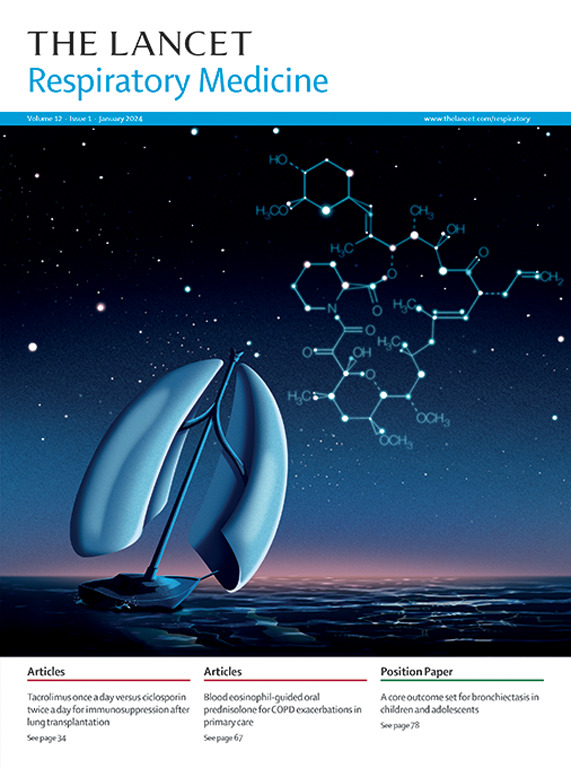Dupilumab for chronic obstructive pulmonary disease with type 2 inflammation: a pooled analysis of two phase 3, randomised, double-blind, placebo-controlled trials
IF 38.7
1区 医学
Q1 CRITICAL CARE MEDICINE
引用次数: 0
Abstract
Background
Dupilumab, a fully human monoclonal antibody, blocks the shared receptor component for IL-4 and IL-13, which are key drivers of type 2 inflammation. We aimed to characterise the efficacy and safety of dupilumab in patients with COPD and type 2 inflammation.Methods
For this pooled analysis, we pooled and analysed data from all patients in the intention-to-treat populations of the phase 3, randomised, double-blind, placebo-controlled BOREAS and NOTUS trials, which comprised 206 hospitals and clinics in BOREAS and 217 in NOTUS in 38 countries across Europe, Asia, North America, South America, Africa, and Australia. Eligible patients were current or former smokers with 10 pack-years or more of smoking history, were aged 40–85 years, had physician-diagnosed COPD for at least 12 months before randomisation, had a post-bronchodilator FEV1/forced vital capacity (FVC) ratio of less than 0·7, had a post-bronchodilator percentage predicted FEV1 of 30–70%, had documented evidence of two moderate or one severe exacerbations of COPD in the previous year (at least one exacerbation had to have occurred on triple therapy), and had blood eosinophil counts 300 cells per μL or more during screening. Patients had to have symptomatic COPD and a reported chronic productive cough for at least 3 months in the previous year. Key exclusion criteria were history of asthma, pulmonary disease other than COPD, or other diagnosed pulmonary or systemic disease associated with elevated blood eosinophil. In both trials, eligible patients were randomly assigned (1:1) via block randomisation with block size 4 to receive subcutaneous dupilumab 300 mg or matching placebo once every 2 weeks for 52 weeks, alongside established background therapy with inhaled corticosteroids, a long-acting β2-agonist, and a long-acting muscarinic antagonist. The primary endpoint was the annualised rate of moderate or severe exacerbations over 52 weeks.Findings
1874 patients were randomly assigned in BOREAS and NOTUS from May 9, 2019, to May 23, 2023; 938 (50·1%) were randomly assigned to the dupilumab groups and 936 (49·9%) were randomly assigned to the placebo groups. Mean age across both groups was 65·1 years (SD 8·2). 622 (33·2%) of 1874 patients were female and 1252 (66·8%) were male. 1628 (86·9%) patients were White, 719 (38·4%) were from Eastern Europe, and 1316 (70·2%) were former smokers. During the 52-week treatment period, 559 moderate or severe exacerbations were reported in 338 (36·0%) of 938 patients in the dupilumab group and 774 exacerbations were reported in 394 (42·1%) of 936 patients in the placebo group. There was a reduction in the annualised rate of moderate or severe exacerbations compared with placebo (annualised exacerbation rate 0·794 in the dupilumab group and 1·156 in the placebo group; incidence rate ratio 0·687, 95% CI 0·595–0·793; p<0·0001). In the dupilumab group, the time to first severe exacerbation was longer than in the placebo group (0·611, 0·409–0·912; p=0·016). However, there was no reduction in the annualised rate of severe exacerbations (annualised exacerbation rate 0·084 in the dupilumab group and 0·124 in the placebo group; 0·674, 0·438–1·037; p=0·073). Treatment-emergent adverse events, serious adverse events, adverse events that led to permanent treatment discontinuation, and adverse events that led to death were similar between the two groups.Interpretation
Dupilumab, as an add-on to standard triple therapy, reduced the annualised rate of moderate or severe exacerbations compared with placebo, highlighting its potential for personalised treatment approaches in patients with COPD with specific clinical endotypes.Funding
Sanofi and Regeneron Pharmaceuticals.Dupilumab治疗慢性阻塞性肺疾病伴2型炎症:两项随机、双盲、安慰剂对照试验的汇总分析
dupilumab是一种全人源单克隆抗体,可阻断IL-4和IL-13的共享受体成分,而IL-4和IL-13是2型炎症的关键驱动因素。我们的目的是描述dupilumab在COPD和2型炎症患者中的有效性和安全性。方法:在本汇总分析中,我们汇总并分析了来自3期随机、双盲、安慰剂对照BOREAS和NOTUS试验的所有意向治疗人群患者的数据,这些患者包括欧洲、亚洲、北美、南美、非洲和澳大利亚38个国家的BOREAS和NOTUS的206家医院和诊所和217家医院和诊所。符合条件的患者为吸烟史≥10包年的吸烟者或既往吸烟者,年龄40-85岁,随机分组前医生诊断为COPD至少12个月,支气管扩张剂后FEV1/强迫肺活量(FVC)比小于0.7,支气管扩张剂后FEV1预测百分比为30-70%。在过去一年中有2次中度或1次重度COPD加重的记录证据(至少1次加重必须发生在三联治疗中),并且在筛查期间血液嗜酸性粒细胞计数为每μL 300细胞或更多。患者必须有症状性慢性阻塞性肺病,并在前一年报告至少3个月的慢性生产性咳嗽。主要的排除标准是哮喘史、COPD以外的肺部疾病或其他诊断出的与血嗜酸性粒细胞升高相关的肺部或全身性疾病。在这两项试验中,符合条件的患者通过块大小为4的块随机化随机分配(1:1),每2周接受一次皮下dupilumab 300 mg或匹配的安慰剂,持续52周,同时采用吸入皮质类固醇、长效β2激动剂和长效毒蕈碱拮抗剂的既定背景治疗。主要终点是52周内中度或重度恶化的年化率。研究结果:2019年5月9日至2023年5月23日,1874名患者被随机分配到BOREAS和NOTUS中;938例(50.1%)随机分配到dupilumab组,936例(49.9%)随机分配到安慰剂组。两组的平均年龄为65.1岁(SD 8.2)。1874例患者中女性622例(33.2%),男性1252例(66.8%)。白人1628例(86.9%),东欧719例(38.4%),前吸烟者1316例(70.2%)。在52周的治疗期间,dupilumab组938例患者中338例(36.0%)报告了559例中度或重度加重,安慰剂组936例患者中394例(42.1%)报告了774例加重。与安慰剂相比,中度或重度加重的年化发生率降低(dupilumab组的年化加重率为0.794,安慰剂组的年化加重率为1.156;发病率比0.687,95% CI 0.595 - 0.793;术;0·0001)。在dupilumab组中,首次严重恶化的时间比安慰剂组长(0.611,0.409 - 0.912;p = 0·016)。然而,严重恶化的年化率没有降低(dupilumab组的年化恶化率为0.084,安慰剂组的年化恶化率为0.124;0·674,0·438 - 1·037;p = 0·073)。治疗中出现的不良事件、严重不良事件、导致永久停止治疗的不良事件和导致死亡的不良事件在两组之间相似。与安慰剂相比,dupilumab作为标准三联疗法的附加疗法,降低了中度或重度恶化的年化率,突出了其在具有特定临床内型的COPD患者中个性化治疗方法的潜力。资助赛诺菲和Regeneron制药公司。
本文章由计算机程序翻译,如有差异,请以英文原文为准。
求助全文
约1分钟内获得全文
求助全文
来源期刊

Lancet Respiratory Medicine
RESPIRATORY SYSTEM-RESPIRATORY SYSTEM
CiteScore
87.10
自引率
0.70%
发文量
572
期刊介绍:
The Lancet Respiratory Medicine is a renowned journal specializing in respiratory medicine and critical care. Our publication features original research that aims to advocate for change or shed light on clinical practices in the field. Additionally, we provide informative reviews on various topics related to respiratory medicine and critical care, ensuring a comprehensive coverage of the subject.
The journal covers a wide range of topics including but not limited to asthma, acute respiratory distress syndrome (ARDS), chronic obstructive pulmonary disease (COPD), tobacco control, intensive care medicine, lung cancer, cystic fibrosis, pneumonia, sarcoidosis, sepsis, mesothelioma, sleep medicine, thoracic and reconstructive surgery, tuberculosis, palliative medicine, influenza, pulmonary hypertension, pulmonary vascular disease, and respiratory infections. By encompassing such a broad spectrum of subjects, we strive to address the diverse needs and interests of our readership.
 求助内容:
求助内容: 应助结果提醒方式:
应助结果提醒方式:


